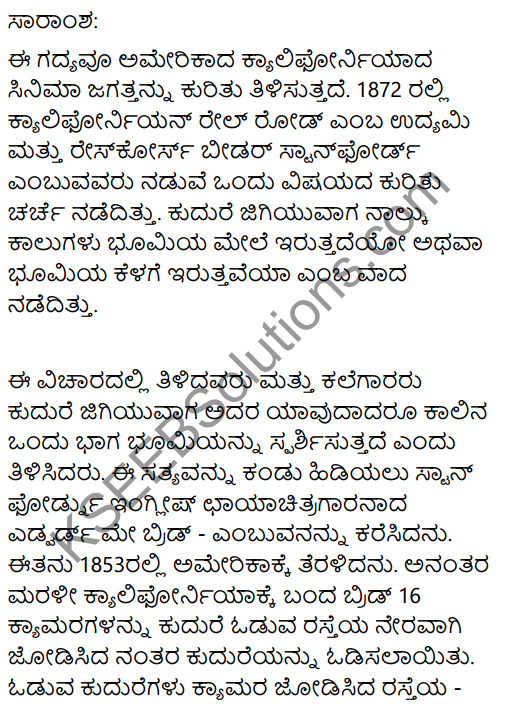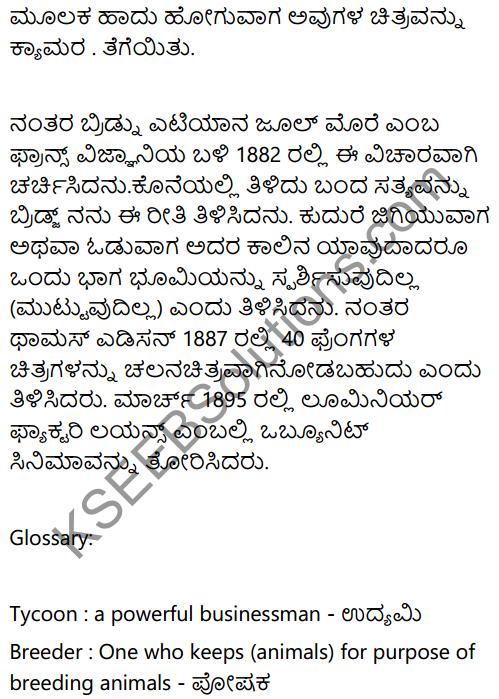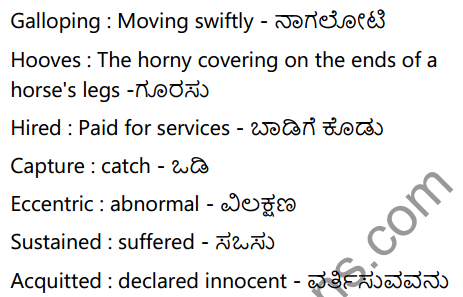Students can Download English Lesson 10 Moving Pictures Questions and Answers, Summary, Notes Pdf, KSEEB Solutions for Class 5 English Karnataka State Board Solutions help you to revise complete Syllabus and score more marks in your examinations.
Karnataka State Board Class 5 English Prose Chapter 10 Moving Pictures
Moving Pictures Questions and Answers, Summary, Notes
Comprehension
I. Answer the following questions:
Question 1.
What was Stanford’s contention of a galloping horse?
Answer:
In 1872, the Californian railroad tycoon and racehorse breeder Stanford had an argument over whether a galloping horse ever has all four hooves of the ground.
Question 2.
What was ‘the truth’ that Standford wanted to capture on a photographic plate?
Answer:
Experts and artists, agreed that the hooves of horses always kept at least some contact with the ground. But Standford contented (disagreed) with the others saying that horses sometimes left the ground completely.
Question 3.
Why did Maybridge set up a battery of sixteen camera parallel to the race track?
Answer:
On his return in 1877, Maybridge set up a battery of 16 cameras parallel to a race track in Sacramento with each camera’s shutter connected to a wire stretched across the race track. As the horse galloped past, its legs tipped the shutters in an order, creating a series of photographs, showing the portion of the horse at each instant.
Question 4.
Who helped Stanford to prove himself right?
Answer:
Maybridge helped Stanford to prove himself right.
Question 5.
What was the special feature of the lightweight camera?
Answer:
It is portable and able to capture 16 images.
II. Read the extract and answer the questions that follow.
1. ‘He had to wait five years for an answer’.
Question a.
Who does ‘he’ refer to?
Answer:
‘He’ refers to ‘Stanford’
Question b.
What ‘answer’ was he waiting for?
Answer:
The ‘answer’ he was waiting for was galloping horses sometimes left the ground completely.
Question c.
Why had he to wait five years?
Answer:
He had to wait for five years for the answer because in 1877, Maybridge, an eccentric photographer helped him to discover the truth.
2. ‘They gave the first demonstration of their cinematograph system’.
Question a.
Who does ‘they’ refer to?
Answer:
Lumiere and his sons.
Question b.
When was the first demonstration given?
Answer:
In March 1895.
Question c.
What is a cinematograph system?
Answer:
The Camera and projections systems capable of making movies that could be viewed by an audience.
III. Say whether the following statements an True or False.
- Stanford was a racehorse jockey. [False]
- Experts and artists agreed that hooves of horses always kept some contact with the ground. [True]
- The images proved all of them wrong. [True]
- Stanford believed that sometimes the hooves of horses don’t have any contact with the ground. [True]
- Thomas Edison and his assistant invented the Kinetograph. [True]
![]()
Language Exercise
I. Vocabulary
1. One word substitution (look into the dictionary for help):

- Part of the earth where life is found: Biosphere
- A person with strange habits: Eccentric
- A book giving information on all branches of knowledge: Encyclopaedia
- A Painting, drawing or photograph a person especially of the head and shoulders: portrait
- Skillful in inventing: Ingenious
![]()
Moving Pictures Summary In English
The lesson is about the movie industry of California. In 1872, the Californian railroad tyloon and racehorse breeder, Standford had an argument over whether a galloping horse ever has all four hooves off the ground. Experts and artists agreed that the hooves of horses always kept at least some contact with the ground. Standford hired an English photographer named Edward Maybridge with the intentions of capturing the truth on a photographic plate.
He emigrated to America in 1850. After coming back he set up a battery of 16 cafeterias parallel to a race track in Sacramento with each camera’s shutter connected to a wire stretched across the race track. As the horse galloped past, its legs tipped the shutters in an order, creating a series of photographs. May bridge struck the images on a rotating disc and sent a ray of a light through them.
Maybridge carried out many studies with Etienne Jules Marey, a ranch scientist who in 1882 invented a single camera. Finally he proved that all the four hooves sometimes were off the ground. Thomas Edison in 1887 invented a camera with images at 40 frames a second, to watch a film. In March 1895, a one – minute film of workers, from the Lumiere’s factories in Lyon was created. This was the evolution of motion pictures.
![]()
Moving Pictures Summary In Kannada



![]()